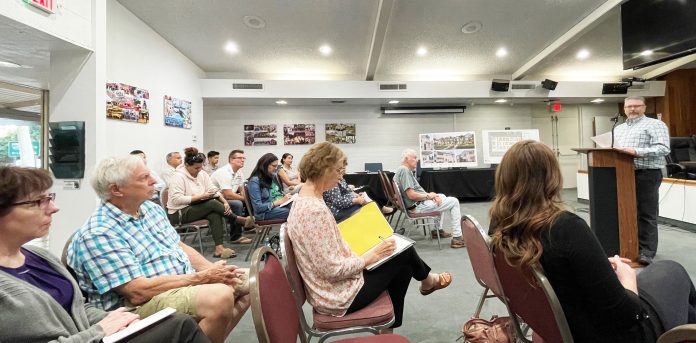
After several months of contentious debate, the Los Alamitos City Council has agreed to take a final vote in August on whether to overrule an aviation advisory panel that has concluded that proposed sites within the city’s approved housing element are “inconsistent” with the land use plan of the city’s military base.

The 2 square mile Joint forces Training Base creates regulatory obstacles for city policy planners.
Courtesy of City of Loss Al
At issue are noise standards and other criteria that could threaten the validity of the city’s approved housing element, which could be decertified, placed at the mercy of the Airport Land Use Commission (ALUC) or even the state’s Housing and Community Development agency if the finding is not overruled by the Council.
The dilemma is unique to Los Alamitos in that the Joint Forces Training Base, built in 1942, literally encompasses two-square miles, which is literally half the land size of the entire city, and which has an extra long runway of more than 8,000 feet that requires additional criteria for safe access.
City officials have expressed frustration that the land occupied by the base must be factored into its housing element, but no housing can be constructed on site.
The ALUC is an advisory board given control of regulating the planning process of sites contiguous to the base, including the Airport Environs Land Use Plan (AELUP), which the airport contends is violated by the city’s most recently approved housing unit.
Therefore, the back-and-forth began with a January 19 memorandum from Lea U. Choum, ALUC’s Executive Officer, who outlined in a seven-page letter to commissioners the reasons the Los Al Housing Element was “inconsistent” with AELUP, mostly sighting noise and height issues.
City officials have flatly disagreed with the ALUC findings of “inconsistency,” according to the staff report.
In addition, Council members were told that four Orange County cities, including Irvine, Costa Mesa, Newport Beach and Seal Beach have all already voted to “overrule” similiar ALUC findings. Moreover, Seal Beach Council member Schelly Sustarsic, who is a member of the ALUC board, voted as a Seal Beach City Council member to overrule the finding of the agency on which she serves, Council member Shelley Hasselbrink told the Council.
While there were other potential housing sites named in the plan, most of the focus has been on the Lampson Project, a mixed-use development of approximately 250 units that is proposed for a site near the flight path of the JFTB main runway and was named by ALUC in their finding.
Shortly thereafter receiving the notification of “inconsistency” from ALUC, the city Council voted 3-2 to notify ALUC of its intention to overrule its finding that the city’s housing element was inconsistent with the airport environs of JFTB.
Council members Trisha Murphy and Emily Hibard, both then relatively new to the Council, voted against the intention to overrule, citing unanswered questions.
Since then, the proposed density of the Lampson Project has continued to draw fierce opposition from many residents who live in the College Park East area along Lampson. Technically, however, they are residents of Seal Beach.
The residents have said they are not opposed to the project, per se, but are opposed to putting so many units in a location where traffic snarls are already commonplace. The high density of Lampson will only inevitably make things worse, they say.
At its July meeting, the city arranged a “study session” at which Council members were free to question staff and consultants. The city’s Ron Noda, Director of Development Services and Nichole Kriste, of Terra Nova, one of the city’s lead consultants on the project, answered many questions during the session.
Carol Churchill, an attorney who lives in Rossmoor, and a former mayor of Signal Hill, who opposes the proposed density of the project, asked the Council to come down on the side of protecting the public interest. She said warnings from government agencies are a clarion call to protect the public interest.
“Those letters indicate that their job, as state agencies, is to protect the public health, safety and welfare,” said Churchill. “They are identifying three sites within the element that are inconsistent with public health, safety, and welfare,” she added.
“And, as community leaders, I’m sure that you want to be recognized as people who promote health safety and welfare, first and foremosrt, over developer profits,” Churchill told the Council.
Elizabeth Hanford, who identified herself as representing a group called People for Housing, called on the Council to move forward with the project.
“We have a (housing) shortage and we need cities to facilitate the development of housing,” said Hanford. Less than half of the cities in Orange County have a compliant housing element, Hanford said, complimenting the city on having an approved housing element.
“For all the work you did to get a compliant housing element, it would be really a shame to lose all of that good work and all of those policies simply because you couldn’t come together. You have an approved housing element,” Hanford said, “which gives you the right to make decisions for yourselves. Don’t give that up.”
“I don’t know what kool-aid everybody’s drinking,” said one woman who did not identify herself, but “there is no housing issue crisis. I don’t know if anybody is reading the news, but hundreds of thousands of people are leaving the state,” she said, suggesting there is no housing crisis.
“I spoke several months ago in support of the Lampson Project and that has not changed,” said local real estate professional Randy Hill. “I see it as a gift to our city that is as close to win win as we could ever have it.”
He said the project “fell into our lap at an opportune time and seems to be the best location residents of Los Alamitos could have hoped for” with “minimal negative impact,” said Hill.
“I m really concerned,” said Hasselbrink, noting that if the city does not overrule ALUC, it could “add another layer of bureauracy for residental, business development, and home improvement projects.”
In addition, Hasselbrink said the commission’s board only met on three occasions out of seven potential meetings in 2023, suggesting Los Al join the list of cities who have already voted to overrule ALUC.
Kriste said that if the city does not overrule ALUC, several things could happen, given new teeth put into the state’s housing laws.
Under one scenario, if ALUC is not overruled, developers and residents could be forced to work through ALUC to get permits on even the most simple projects, under another, the City Council could lose control over housing if developers use “builders remedy” to build at will, the Council was told.
In essense, the city could potentially lose the benefit of its approved housing element which does grant city officials a measure of control and governing power to regulate housing in the city, city attorney Michael Daudt confirmed.
“To be clear, I’m not a housing fan,” said Mayor Tanya Doby. “I do not think we need as many allocations as we received and I will say that openly and in any room that I’m in but the only way to maintain the control of our certified housing element is through an override of ALUC’s finding,” said Doby.
In addition, Doby suggested much of the ALUC determination is largely based on 2015 data.
“The entire city could be affected,” said Kriste, if ALUC is not overruled.
City Manager Chet Simmons said all of the questions raised during the session would be answered within the next 30 days as Hasselbrink moved to have a final vote on the issue at the Council’s August meeting.
Following the ALUC discussion, Murphy moved, seconded by Hibard, to bring back to the Council on its August agenda a discussion over ethics and conflicts of interest between the city’s law firm and former interim city manager Les Johnson, now a planner at one of the companies involved in the pending Lampson Project.
